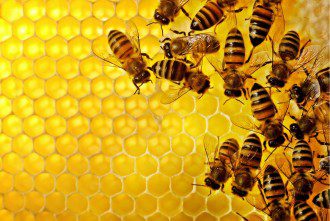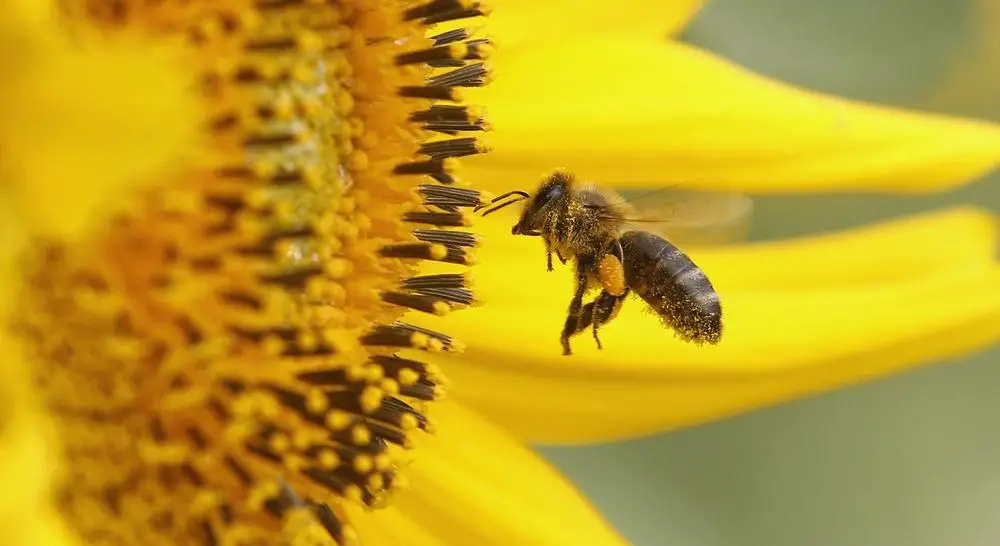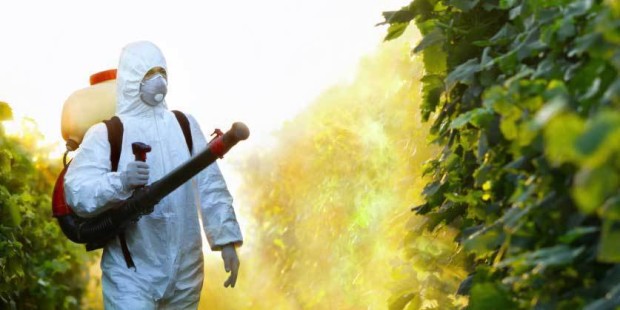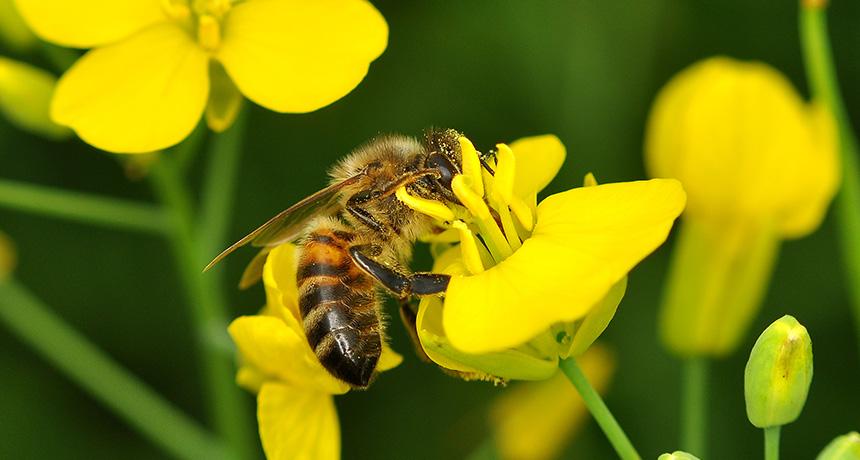1st July 2016
Contributing writer for Wake Up World
Honeybees have had a hard time over the last several decades — colony collapse disorder, habitat destruction and exposure to increasing levels of chemicals in the environment. Approximately 40% of bee colonies in the U.S. perished last year, and the numbers are climbing.
Dr. Dennis van Engelsdorp, an entomologist from the University of Maryland, believes there are three factors influencing the decline in honeybees: The varroa mite, poor nutrition and pesticides. Researchers are especially concerned about the latest findings from Purdue University, which found honeybees pick up an ‘astonishing’ level of pesticides during their rounds — much higher than previously thought.
[pro_ad_display_adzone id=”110028″]
Decline of the Honeybee:
Below are the three components listed by Dr. van Engelsdorp that are synergistically wiping out the bee population in the United States:
Varroa destructor mites are assumed to have migrated to the U.S. in the 1980s. The mites latch onto the honeybee and suck its blood — leading to death in many. Unfortunately, the mite spreads easily from one colony to another, killing entire populations of the insect.
Pesticides have garnered quite a bit of press in the media — especially a class called neonicotinoids — as exceptionally damaging to bees and other pollinators. Glyphosate — otherwise known as Monsanto’s Roundup Ready — has also been implicated in colony collapse disorder. The herbicide is a neurotoxin, causes endocrine hormone and immune disruption, destroys beneficial bacteria and stimulates fungal overgrowth in bees.
Habitat destruction contributes to dwindling numbers of the insects because it fosters poor nutrition within the colonies. Time magazine reports:
“Bees need a varied diet of different pollens in order to grow into strong, healthy workers,” explains Dr. Heather Mattila, a honeybee biologist at Wellesley College. Unfortunately, a country once filled with meadows of diverse, pollen-packed wildflowers is now blanketed by crops, manicured lawns, and mown fields barren of pollen sources. “A green space can be a green desert if it doesn’t have flowering plants that are bee-friendly,” Mattila adds.”
Needless to say, beekeepers, farmers, scientists and government officials are worried — for good reason. Not only is it unacceptable to lose almost half of the bee colonies in the U.S. from an ethical standpoint, but the loss will also severely impact growing food, exports, farms and the entire economy of the country. Particular crops will be impossible to grow without enough honeybees — like almonds, certain berries and apples. Bees also contribute around $15 billion to U.S. crop production. Financial and moral implications aside, another aspect is now drawing attention to the plight of the honeybee — pesticide contamination in honey and bee pollen.
Agricultural and pest management chemicals don’t respect boundaries.
Scientists have know for some time now that a shockingly high number of honey products are contaminated with Roundup Ready. As I wrote in Glyphosate Nation: Troublesome Roundup Herbicide Found Throughout U.S. Food Supply — Organics Too:
“Out of the 69 honey samples evaluated, forty-one (59%) exhibited glyphosate residues above the established LOQ — ranging between 17 and 163 ppb, with an average mean of 64 ppb. What’s more, five of the eleven organic honey samples (45%) tested positive for glyphosate with a range of 26 to 93 ppb and a mean of 50ppb.”
Since the team didn’t track glyphosate residues below the limit of quantification, there’s a good chance the honey tested may contain the herbicide in more samples than the study indicates. The overall picture could be much worse.
And now researchers at Purdue University have uncovered another disturbing trend: exceedingly high levels of pesticides in bee pollen. However, a significant portion of the toxins weren’t from agricultural crops but from pesticides used by homeowners and urban landscapers.
“Although crop pollen was only a minor part of what they collected, bees in our study were exposed to a far wider range of chemicals than we expected,” said Christian Krupke, professor of entomology at Purdue University. “The sheer numbers of pesticides we found in pollen samples were astonishing. Agricultural chemicals are only part of the problem. Homeowners and urban landscapes are big contributors, even when hives are directly adjacent to crop fields.” [source]
According to the university press release, residues of pesticides were detected from nine chemical classes, including neonicotinoids (used on corn and soybean seeds) and pyrethroids (typically used to control mosquito populations and other pests). In fact, pyrethroids were found to be in the highest concentration of all the pesticides detected. While both neonicotinoids and pyrethroids are toxic to bees, pyrethroids are particularly dangerous because they are used in areas bees are most likely to visit — near homes and gardens that have a variety of different flowering plants. This in turn exposes bees to higher levels of chemicals more frequently — not just in a specific crop growing season. There was also a spike in pyrethroids contamination in August and September — two months where homeowners spray the chemical to control mosquitoes, hornets and other pests. DEET — a highly toxic insect repellant — was also detected in the bee pollen.
Elizabeth Long, an assistant professor of entomology at The Ohio State University, said she was “surprised and concerned” by the diversity of pesticides found in pollen. She adds, “If you care about bees as a homeowner, only use insecticides when you really need to because bees will come into contact with them.”
Here’s what you can do to help:
- Ditch insecticides. Instead, try this DIY herbal repellant and explore these landscaping ideas to naturally reduce pests.
- Petition local government to abandon the use of Roundup Ready and pyrethroids altogether — especially in public spaces like parks and landscaping around government buildings. Likewise, send a strong message to your local home improvement and gardening centers to phaseout harmful pesticides and herbicides from their stores.
- Participate in a “Great Seed Bomb” to encourage pollinator habitats or, better yet, organize one yourself to multiply the impact.
Article sources:
- www.nature.com/ncomms/2016/160531/ncomms11629/full/ncomms11629.html
- www.brownfieldagnews.com/2016/06/02/study-shows-honeybees-arent-just-picking-pesticides-via-ag-crops
- www.eurekalert.org/pub_releases/2016-05/pu-hpu052616.php
About the author:
 Carolanne Wright enthusiastically believes if we want to see change in the world, we need to be the change. As a nutritionist, natural foods chef and wellness coach, Carolanne has encouraged others to embrace a healthy lifestyle of organic living, gratefulness and joyful orientation for over 13 years.
Carolanne Wright enthusiastically believes if we want to see change in the world, we need to be the change. As a nutritionist, natural foods chef and wellness coach, Carolanne has encouraged others to embrace a healthy lifestyle of organic living, gratefulness and joyful orientation for over 13 years.
Through her website Thrive-Living.net, she looks forward to connecting with other like-minded people from around the world who share a similar vision. You can also follow Carolanne on Facebook, Twitter and Pinterest.
Further reading from Carolanne Wright:
- Don’t Ask, Just Plant — Taking Back Our Food Sovereignty with Guerrilla Gardening
- Seed Bombs: A Creative (and Fun) Mission to Save the Bees and Butterflies
- Autistic Boy with Higher IQ Than Einstein Discovers Gift After Removal from State-Run Therapy
- Dr Sebi: The Man Who Cures Aids, Cancer, Diabetes and More
- Big Pharma and Organized Crime — They are More Similar Than You May Think
- Emotional Energetic Healing: The Future of Medicine is Here
- The Greenhouse of the Future: Grow Your Own Food Year-Round With This Revolutionary System
- CDC Concealed Link Between Thimerosal and Autism for Over a Decade, Forced to Release Incriminating Documents
[pro_ad_display_adzone id=”110027″]










